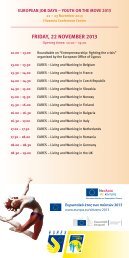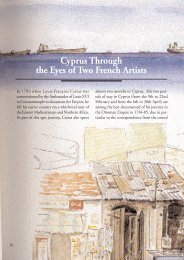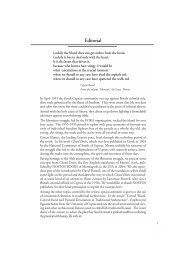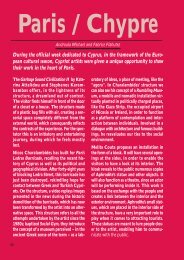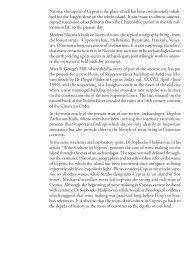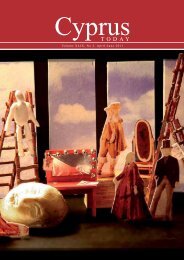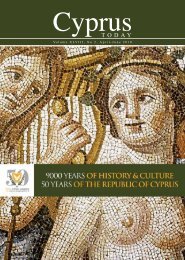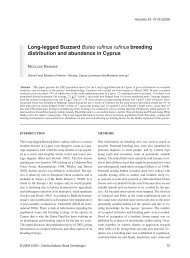Editorial
Editorial
Editorial
You also want an ePaper? Increase the reach of your titles
YUMPU automatically turns print PDFs into web optimized ePapers that Google loves.
of the site date to the Roman and Early Christian<br />
period. Its mosaics and in particular those<br />
of the Annex of Eustolios, dated to the early 5th<br />
century AD, were the first mosaics discovered<br />
on the island that acquired international importance:<br />
they are one of the few monuments,<br />
world-wide, that illustrate the passage from<br />
Paganism to Christianity.<br />
The second paper was an "Evaluation of the<br />
Orpheus Mosaic Project, Paphos, Cyprus" and<br />
was presented by Dr Martha Demas, from the<br />
Getty Conservation Institute, written in collaboration<br />
with Neville Agnew, Thomas<br />
Roby, Demetrios Michaelides, Giorgio Capriotti<br />
and Niki Savvides. The conservation of the<br />
Orpheus mosaic was a project carried out by<br />
the Getty Conservation Institute in collaboration<br />
with the Department of Antiquities of<br />
Cyprus in 1988-1992. It involved the conservation<br />
of the floor mosaic depicting Orpheus,<br />
from the homonymous house in Paphos, by lifting<br />
it using the rolling method and relaying it<br />
in situ. As this was a method infrequently used,<br />
the project was seen as an opportunity to<br />
combine a training component by allowing the<br />
participation in the project of a group of conservators<br />
from the Mediterranean. The project<br />
concluded with the installation of a prototype<br />
temporary shelter over the mosaic, and was<br />
followed by a publication analysing the philosophy<br />
and the approach behind it. As the shelter<br />
is still on site, it was decided that this was a<br />
good opportunity to evaluate a well-known project,<br />
by assessing the effectiveness of both the<br />
shelter and the conservation method used for<br />
the mosaic.<br />
Generally speaking, the conference pointed out<br />
the current trends in the conservation of mosaics<br />
and the management of archaeological sites.<br />
The presentations showed that the approach to<br />
mosaic conservation has not been static over the<br />
last thirty years but has evolved immensely from<br />
one offering limited options for a single<br />
mosaic (namely detachment), to one involving<br />
complex decision-making and planning with a<br />
range of viable in situ alternatives. The significance<br />
of sustainability, cultural heritage values,<br />
long-term planning, and stakeholder participation<br />
in the decision-making process<br />
were also widely acknowledged. Regarding stakeholder<br />
participation, many papers discussed the<br />
importance of collaboration between archaeologists,<br />
conservators, architects, and the local<br />
people in making decisions concerning the conservation<br />
of cultural heritage.<br />
The conference included excursions to archaeological<br />
sites with mosaics and sites where mosaic<br />
conservation projects are currently running:<br />
Thuburbo Maius, Jebel Oust, Carthage, Neapolis<br />
(both the site and the regional museum with<br />
the magnificent mosaics, perhaps the best of<br />
their kind in Tunisia). A reception was hosted<br />
at the Bardo Museum in Tunis, a spectacular<br />
17th century palace, which houses one of the<br />
best collections of mosaics in the world. There<br />
was also an optional post-conference excursion<br />
to some of the spectacular archaeological sites<br />
of Libya. Starting with Tripoli, the participants<br />
visited the Castle, the Medina and Tripoli Museum.<br />
But the visit to sites of Tripolitania -<br />
Leptis Magna and its museum, Sabratha and<br />
Villa Silene were the highlights of the tour.<br />
During the conference, Demetrios Michaelides,<br />
was re-elected President, for the next triennium.<br />
The next international conference of the<br />
ICCM will take place at Palermo in Sicily, in<br />
2008.<br />
The present shelter at the Annex of Eustolios,<br />
looking SW.<br />
103



